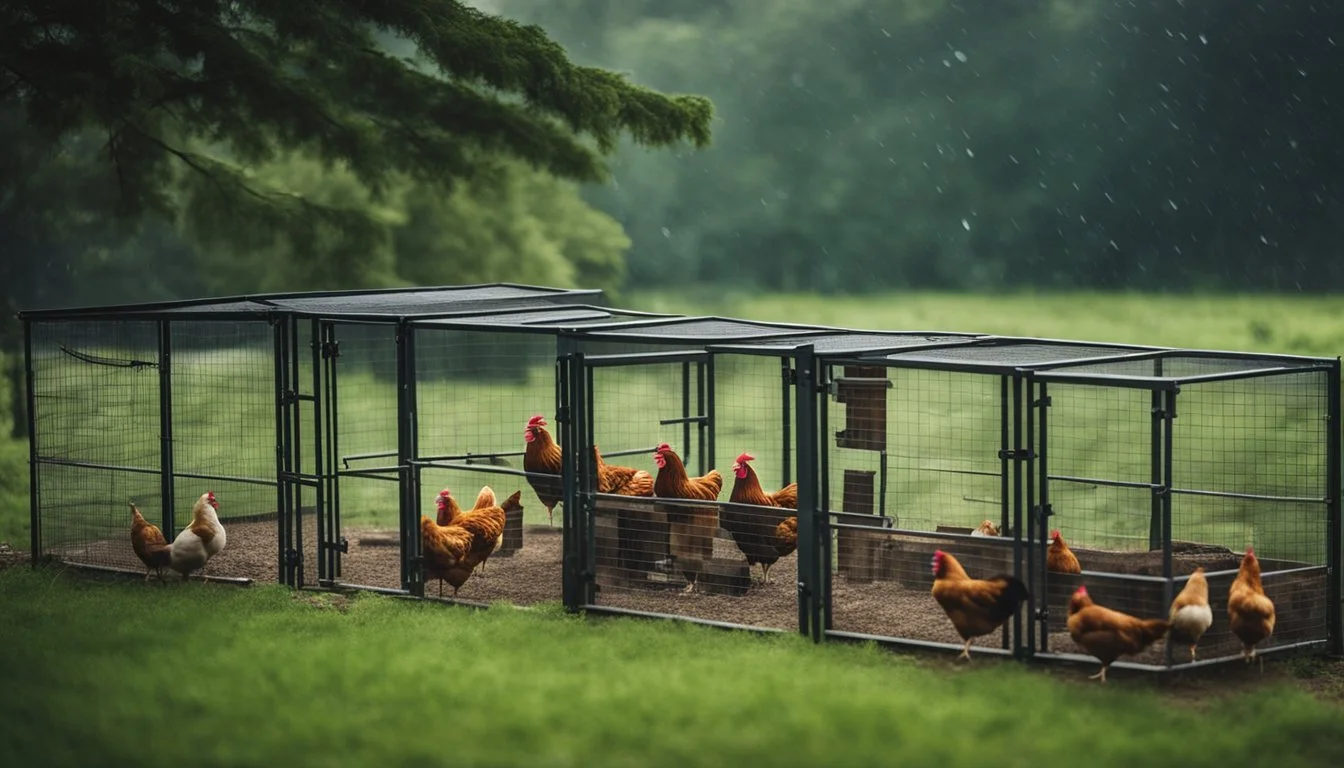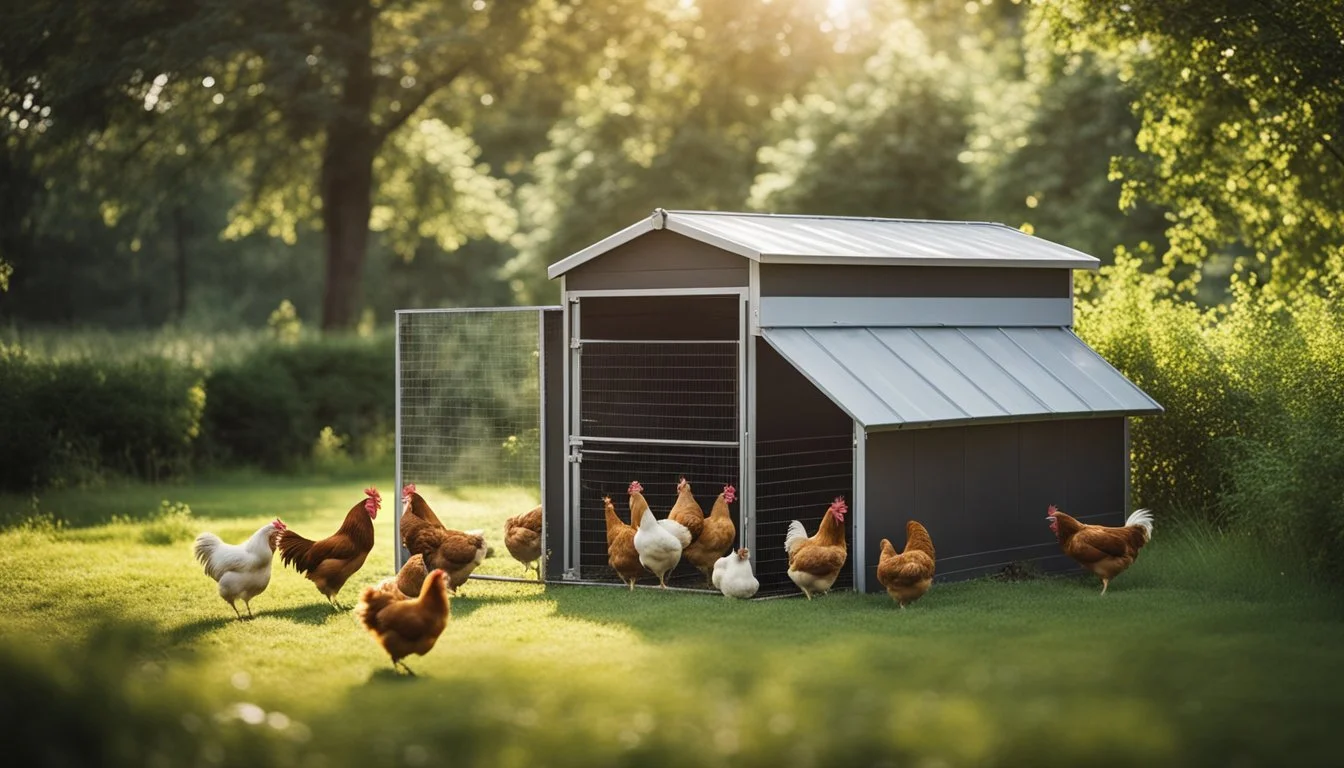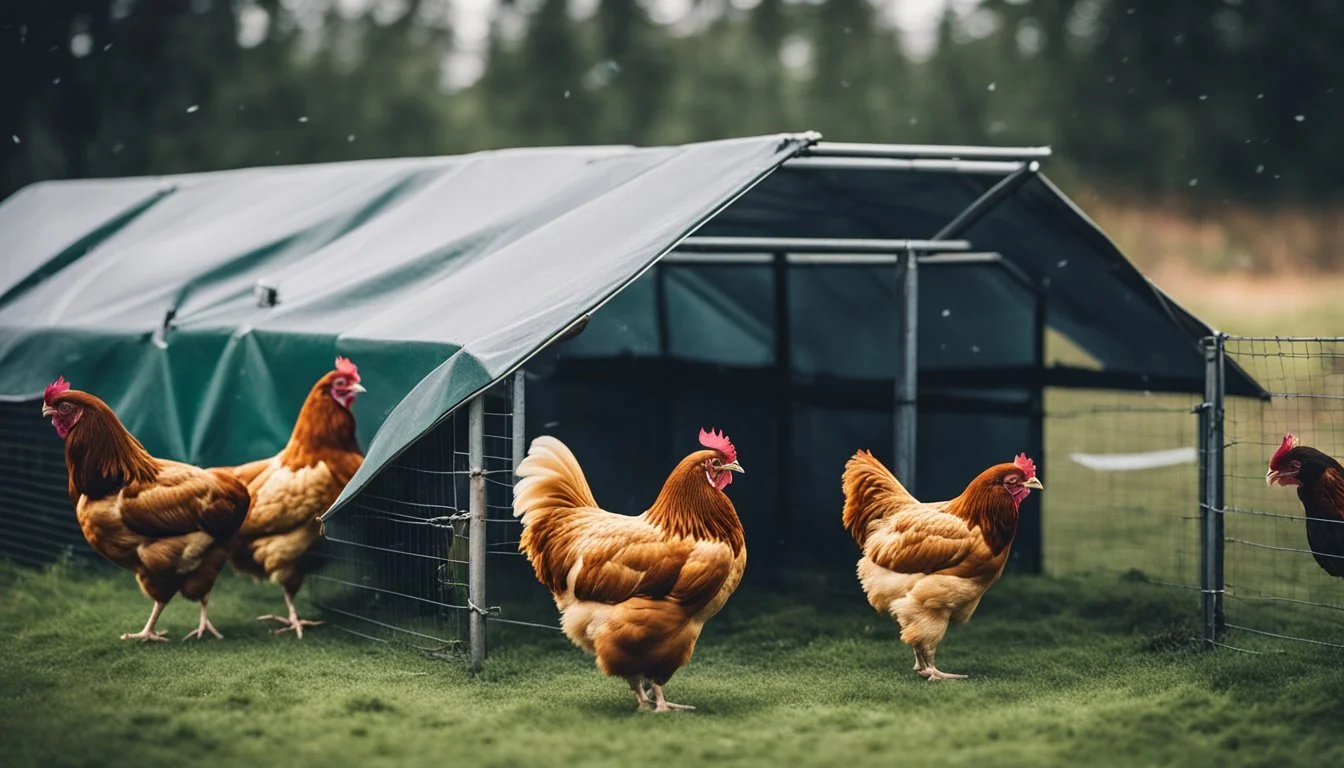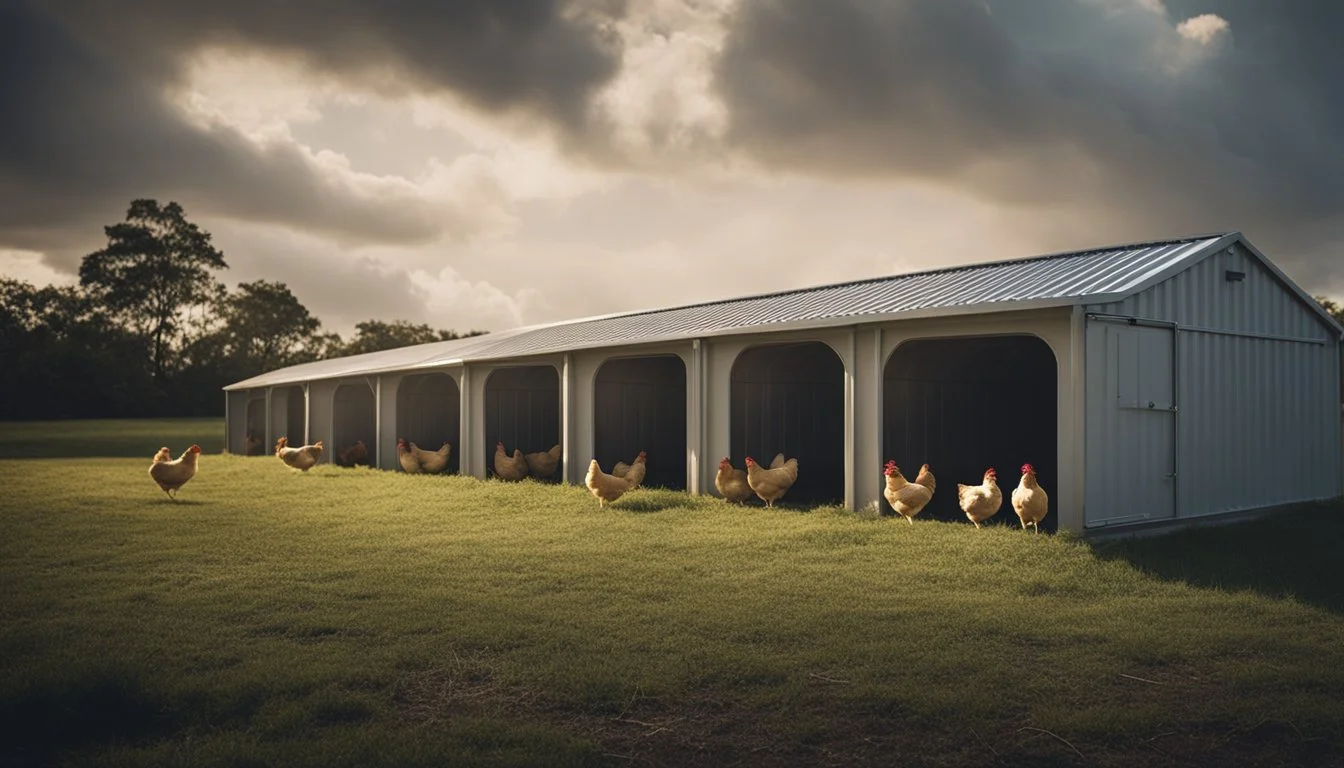8 Ways to Keep Your Chickens Safe During a Storm
Essential Tips for Poultry Protection
Storms can pose significant threats to backyard flocks, stressing the importance of proper preparation and safety measures. Chicken owners need to be aware of effective strategies to protect their animals from the potential dangers that extreme weather can bring, including heavy rains, strong winds, and flooding.
Understanding how to keep chickens safe during storms can ensure their well-being and reduce the risk of injury or loss. This article discusses essential tips and practices that can help safeguard your chickens when severe weather hits.
1) Install Secure Coop Locks
Secure coop locks are essential to protect chickens during a storm. Standard latches can easily be opened by high winds or even curious predators. Heavy-duty padlocks or combination locks are more reliable.
These locks should be installed on all doors and access points. This ensures that no part of the coop can be accidentally opened.
Besides locks, consider reinforced hinges. Strong hinges prevent doors from being ripped away. This is particularly important in areas prone to severe weather.
It's also wise to inspect locks regularly. Wear and tear can compromise security. If any lock appears worn, replace it immediately.
Backup locking mechanisms provide additional safety. Installing a secondary latch on the inside can add an extra layer of security.
Durability is key when choosing locks. Opt for materials that withstand moisture and rust. Stainless steel or galvanized locks are good choices.
In summary, secure coop locks are a simple yet effective measure to keep chickens safe during a storm. Strong, durable, and well-maintained locks can make all the difference. Regular checks and maintenance ensure their reliability when it matters most.
2) Use weather-resistant tarps
Weather-resistant tarps are essential for protecting chickens during a storm. These tarps provide a sturdy barrier against heavy rain, wind, and hail.
Choose a tarp that is thick and durable, ideally with a thickness of at least 5.5 Mil. Thicker tarps offer better protection and longevity.
Securing the tarp properly is important. Attach it firmly to the coop and run using strong clips or bungee cords. Ensure it covers all exposed areas without leaving gaps where rain or wind can enter.
Consider the placement of the tarp. Position it at an angle to allow rainwater to run off easily, preventing water from pooling and adding unnecessary weight.
Opt for tarps with grommets. Grommets make it easier to attach the tarp securely and distribute tension evenly, reducing the risk of tearing.
Metal sheets can be used for additional reinforcement. They add extra strength and durability to withstand severe weather conditions.
Check the tarp regularly for wear and tear, and replace it if it shows signs of damage. A weather-resistant tarp in good condition ensures the coop remains dry and safe for the chickens.
3) Elevate the Coop
Elevating the chicken coop is essential, especially in flood-prone areas. This prevents water from damaging the structure and keeps the chickens safe and dry. Raising the coop on stilts or a platform ensures it stays above water during heavy rains or storm surges.
Using sturdy materials for the elevation is crucial. Wood or metal supports can provide a stable base. Ensure the platform is high enough to avoid any potential flooding, typically about 1 to 2 feet off the ground.
Elevating the coop also improves ventilation. Air can circulate beneath the structure, helping to regulate temperature and reduce moisture. This aids in maintaining a healthier environment for the chickens. Elevated coops are also less likely to attract predators like rats or snakes.
4) Reinforce Coop Walls
Reinforcing the walls of the chicken coop is crucial for sheltering your flock during a storm. A sturdy and well-built coop can withstand heavy winds and intense rain, keeping your chickens safe and secure. Use durable materials like treated wood or plywood to create a strong foundation for the walls.
For added security, consider installing hardware cloth over the walls. Unlike chicken wire, hardware cloth is more robust and can prevent predators from entering during tumultuous weather. It also helps keep out smaller animals and pests that might seek refuge in the coop.
Ensure all gaps and holes in the coop walls are sealed. Even small openings can become problematic as they allow water to seep in and weaken the overall structure. It’s essential to check for any vulnerabilities and address them quickly.
Additionally, reinforcing the interior of the coop can provide extra stability. Using strong, paintable materials for the interior walls can also make cleaning easier and help maintain a hygienic environment. Regular inspections and maintenance of the coop walls can go a long way in protecting your chickens during adverse weather conditions.
5) Provide Proper Ventilation
Proper ventilation is crucial for keeping chickens safe during a storm. It helps to manage humidity levels, reducing the risk of respiratory problems and mold growth inside the coop.
Ventilation should allow for air circulation without creating drafts directly on the chickens. This can be achieved by installing vents high up on the walls of the coop.
During a storm, ensure that ventilation openings are not exposed to rain. Adjustable vents can be particularly useful, as they can be closed or angled to prevent water from entering.
Good ventilation also helps to remove ammonia build-up from chicken waste. Ammonia can be harmful to chickens' respiratory systems, especially when they are confined inside the coop during a storm.
Maintaining clean and dry bedding inside the coop can further support proper airflow and reduce moisture levels.
6) Have an Evacuation Plan
Developing an evacuation plan is crucial for ensuring the safety of your chickens during a storm. Start by identifying a safe location where you can move your chickens if necessary. This location could be with friends or family who live outside the storm-prone area.
Prepare containers or crates that will allow for easy transportation of your chickens. Pillowcases can serve as a quick solution; cut a hole for the chicken's head and tie it securely. This method ensures that the chickens remain calm and contained during transit.
Ensure that you have a reliable mode of transport. Your vehicle should be ready and capable of carrying both the chickens and their necessary supplies. It's also wise to keep emergency supplies like food, water, and first aid kits easily accessible and prepared for a quick departure.
Make arrangements for temporary housing at your evacuation site. Whether it's a garage, basement, or temporary coop, ensure that the space is safe and has adequate ventilation and protection from the elements.
Communicate your plan with all household members. Everyone should know their specific roles and responsibilities. This coordination will make the evacuation process smoother and quicker.
By planning ahead and preparing for all contingencies, you can significantly increase the chances of your chickens' safety during a storm.
7) Add insulation
Insulating the chicken coop is essential to keep your chickens safe during a storm. Proper insulation minimizes drafts and provides a buffer against extreme temperatures.
Foam boards and tarps are popular choices for insulation. Foam boards are particularly effective because they are easy to cut and place around the coop. Tarps can also add an extra layer of protection.
It's important not to seal the coop too tightly. Ventilation is necessary to prevent moisture buildup inside the coop. Moisture can lead to frostbite on the chickens' combs and wattles.
Clean, dry bedding like straw or wood shavings on the floor adds insulation and keeps the coop warm. Deep bedding also helps protect the chickens' feet from the cold ground.
Insulation not only helps in storms but also during regular cold weather. Your chickens will remain comfortable and healthy with this added protection.
8) Use a Storm Shelter
Using a storm shelter can provide a safe haven for chickens during extreme weather events. These shelters should be sturdy, well-ventilated, and free of potential hazards.
A storm shelter can be an existing structure such as a basement or a specially constructed space.
Ensure the shelter is large enough to accommodate all chickens comfortably. Also, provide adequate food and water for the duration of the storm.
It's crucial to check the shelter regularly for structural integrity and potential entry points for predators. By doing this, chickens remain safe from the storm and any opportunistic wildlife.
Incorporate sandbags or other flood prevention measures if the area is prone to flooding.
Keep the chickens calm by minimizing loud noises and sudden movements. A calm environment will make it easier for them to endure the storm.
Understanding Storm Threats
Storms can pose significant risks to chickens, including physical harm from debris and exposure to elements. Knowing the types of storms and their potential dangers helps in preparing adequately to protect your flock.
Types of Storms
Thunderstorms can bring heavy rain, strong winds, and lightning. These storms can be sudden and may cause immediate hazards such as fallen branches or flooding.
Tornadoes involve extremely high winds that can easily destroy poorly built coops. The flying debris poses a significant risk to the safety of chickens.
Snowstorms and blizzards feature heavy snowfall and frigid temperatures. They can lead to coop damage, water freezing, and health issues due to prolonged cold exposure.
Hurricanes and tropical storms involve a combination of heavy rain, strong winds, and potential flooding. These storms cover larger areas and can last several days, posing a prolonged threat.
Potential Dangers to Chickens
Flying debris, such as branches or roofing materials, can cause serious injuries to chickens. It is crucial to ensure that the coop is robust and free from loose materials.
Flooding presents a risk of drowning and can lead to damp, unhealthy conditions inside the coop. It is important to check for flooding risks and ensure proper drainage around the coop area.
High winds can topple poorly secured coops or runs. Reinforcement of the structure is essential to prevent collapses.
Extreme cold, especially in snowstorms, can lead to hypothermia or frostbite in chickens. Ensuring warmth inside the coop and minimizing drafts are important protective measures.
Exposure to rain can soak chickens and their bedding, leading to illnesses. Providing dry, sheltered areas within the coop is essential for their health.
Storm-induced stress can also affect chickens, leading to lower egg production and susceptibility to illness. Measures such as spending extra time with the flock or providing distractions can help mitigate stress effects.
Preparing the Chicken Coop
Ensuring the safety of your chickens during a storm requires reinforcing the coop’s structure, maintaining proper ventilation, and securing feed and water sources. Each of these actions addresses specific hazards posed by severe weather conditions.
Reinforcing the Structure
First and foremost, checking the integrity of your chicken coop’s structure is crucial. Inspect for any loose panels, weak points, or gaps where wind and rain might infiltrate. Strengthen these areas by adding extra screws, nails, or brackets.
Materials needed for reinforcement:
Heavy-duty nails or screws
Metal brackets
Wooden or metal braces
Hardware mesh
Cover any windows or openings with hardware mesh to prevent debris from entering. Adding wooden or metal braces to doors and windows can further increase structural stability, ensuring the coop withstands high winds.
Ensuring Proper Ventilation
While securing the structure is essential, maintaining proper ventilation within the coop is equally important. Improper ventilation can lead to moisture buildup, which breeds bacteria and mold. Inspect vents and make sure they are not blocked.
Tips for ventilation:
Install adjustable vents: Allows control over airflow.
Ensure vents are protected: Use mesh coverings to keep out debris.
Position vents strategically: Place them above the chickens' roosting level.
During storms, temporary ventilation solutions may also include slightly opening windows or doors while ensuring they are shielded from rain to allow fresh air circulation without compromising shelter.
Securing Feed and Water Sources
In preparation for a storm, securing feed and water to prevent contamination and ensure access is vital. Water sources should be stored in watertight containers to prevent flooding or contamination from debris.
Steps to secure feed and water:
Store feed in sealed containers: Airtight bins keep feed dry and safe from pests.
Elevate feeders and waterers: Place them on raised platforms to avoid waterlogging.
Plan for extra water: Fill additional containers ahead of the storm to ensure an adequate supply.
These measures will help maintain the health and safety of your flock during severe weather, ensuring they have access to necessary resources.
Emergency Plans and Protocols
In any storm scenario, it is crucial to have a detailed plan that outlines evacuation steps and immediate first aid measures for your flock. Preparation helps ensure their safety and well-being during emergencies.
Creating an Evacuation Plan
Creating an evacuation plan for your chickens requires careful thought and organization. Start by identifying a safe location where your chickens can be relocated, such as a neighbor's sturdy garage or a designated shelter. Ensure this location is equipped to house the chickens for an extended period if needed.
Assign family members specific tasks in the evacuation process. This might include rounding up the chickens or gathering essential supplies. Practice these tasks regularly to ensure everyone knows their role and can act quickly under pressure.
Prepare a transportation cage or coop, lining it with straw or soft bedding to keep your chickens comfortable during transit. Have a first aid kit, water, and enough food for at least a week readily available. Label all items clearly and keep them in an accessible spot to grab quickly during an emergency.
First Aid for Injured Chickens
In case of injury during a storm, having a well-stocked first aid kit is essential. Include items such as antiseptic solution, bandages, scissors, and tweezers. It’s also helpful to have blood clotting powder and electrolytes on hand.
Check your chickens immediately after the storm has passed for any signs of injuries such as cuts, broken bones, or shock. Gently clean any wounds with antiseptic and apply bandages if necessary. If a chicken is in shock, keep it warm and isolated from the rest of the flock until it recovers.
Contact a veterinarian if any injuries seem severe or if you are unsure about how to treat them properly. Keeping the first aid kit and veterinary contact information handy can save precious time in an emergency.









